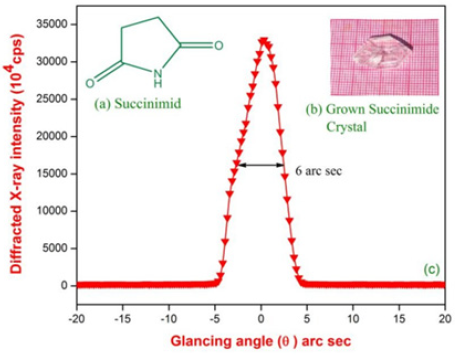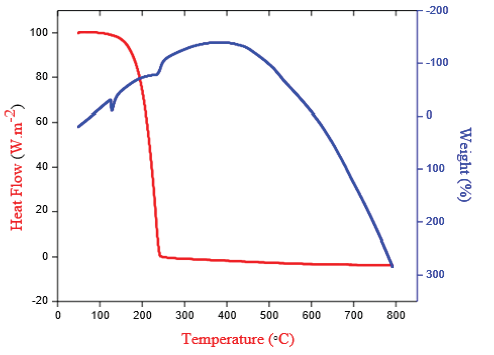- Submissions

Full Text
Aspects in Mining & Mineral Science
Synthesis, Growth and Nonlinear Optical Properties of a Novel Organic Single Crystal: Succinimide
Suresh S and Mohan Kumar R*
Department of Physics, Presidency College, Chennai-600 005, India
*Corresponding author: R Mohan Kumar, Associate Professor, Department of Physics, Presidency College, Chennai-600 005, India
Submission: April 06, 2020;Published: May 25, 2021

ISSN 2578-0255Volume6 Issue4
Abstract
Organic single crystal of Succinimide (SM) was grown from aqueous solution by slow solvent evaporation technique. Succinimide crystallized in orthorhombic system with non-centrosymmetric space group of Pbca. The crystalline perfection of Succinimide crystal was evaluated by high resolution X-ray diffraction analysis and found that the crystalline perfection is exceptional without having any low or very low angle internal structural grain boundaries. Optical transmission study and band gap energy was estimated by utilizing UV-Vis spectrum. Laser damage threshold value of Succinimide (3.2GW/cm2) was estimated and it is relatively higher than that of p-Toluidinium L-Tartrate single crystal (2.0GW/cm2). Thermo gravimetric studies revealed the thermal stability and decomposition pattern of the material. Nonlinear optical property of the Succinimide crystal was confirmed by Kurtz and Perry technique. Second harmonic generation conversion efficiency of the grown crystal showed the suitability of the frequency conversion applications.
Keywords: Crystal growth; Grain boundaries; Thermal properties; Optical materials and properties
Introduction
Organic nonlinear optical crystal plays an important role in second harmonic generation, frequency mixing, electro-optic modulation, optical parametric oscillation, optical communication, and data storage. Moreover, the low optical loss, high thermal and large nonlinear optical susceptibility are the most important requirements of any nonlinear optical crystal for potential applications [1,2]. Due to the base character of Succinimide, (C4H5NO2) it is used to form covalent bonds between proteins or peptides, plastics and white solid which are used in a variety of organic synthesis. N-chlorosuccinimide, N-Hydroxy succinimide some organic nonlinear optical materials have been reported [3,4]. In the present investigation, the growth and characterization of Succinimide have been studied. As this molecule crystallizes with noncentrosymmetric crystal structure, we localized our interest towards the systematic studies of growth aspects, single crystal and HRXRD, UV-Vis, thermal analysis, Laser damage threshold and nonlinear optical properties of Succinimide crystal.
Experimental
Material synthesis and crystal growth
Succinimide salt with (SM) molecular weight of 99.09g/mol was purchased from Delhi. The solubility of the SM was found out at room temperature (32 °C). Succinimide of 10gm was dissolved in 50ml of de-ionized water and allowed for slow solvent evaporation. The chemical reaction scheme of SM is illustrated in Figure 1(a). The solution was stirred for about 6h to get homogenization. The purity of the synthesized salt was improved by recrystallisation process. The colorless transparent single crystal of size about 20×9×2mm3 was obtained in 37 days as shown in Figure 1(b).
Results and Discussion
XRD studies indicate that Succinimide crystallizes in triclinic system with non-centrosymmetric space group of Pbca. Single crystal X-ray diffraction study was performed for SM crystal and the estimated cell dimensions are a=7.50Å, b=9.62Å, c=12.75Å and α=70.25°, β=76.30°, γ=82.71° and Volume V=919Å3. These results agreed very well with the reported values [5]. The crystalline perfection of SM crystal was revealed by high resolution X-ray diffraction analysis. The Diffraction Curve (DC) was recorded for Succinimide sample in symmetrical Bragg’s geometry using a multi crystal X-ray diffractometer with MoKα1 radiation [6]. The resultant DC (Figure 1(c)) contains a single sharp peak without any shoulder peaks with FWHM of 6 arc sec which indicates that the specimen is free from internal grain boundaries. It is more than the expected value from the wave theory of dynamical X-ray diffraction. The very low FWHM of Succinimide indicates that the crystalline perfection is quite good. UV-Visible spectrum was recorded for Succinimide crystal of 1mm thickness using T90+ UV/ VIS spectrometer in the range 200-900nm as shown in Figure 2(a). It reveals that grown crystal has wide transmission in the entire range without any absorption peak. The lower cutoff wavelength 291nm and transparency (60%) are suitable for optics and electrooptics device applications. The variation of (αhν)2 with ‘hν’ in the fundamental absorption region is illustrated in Figure 2(b). The band gap was found to be 4.1eV. Hence, it is an admirable entrant for nonlinear optical applications. TG and DTA studies using Simultaneous STA-600 Perkin Elmer thermal analyzer were carried out in nitrogen atmosphere at the temperature range 50-800 °C (Figure 3). It is observed that there is no weight loss up to 130 °C in the TGA curve. The major weight loss started at 242 °C, is due to the decomposition of Succinimide crystal. In the DTA trace, there is a minute endothermic noted at 128 °C and a major endothermic observed at 240 °C. Both these endothermic matched with the decomposition in the TGA curve. Hence, the SM crystal could be valuable for the optical device fabrications up to 130 °C.
Figure 1: (a) Material synthesis scheme of SM (b) Photograph of as grown SM crystal and (c) HRXRD diffraction curve of SM crystal.

Figure 2: (a) UV-Visible transmittance spectrum and (b) Tauc’s plot of SM crystal.

Figure 3: TG and DTA curves of SM crystal.

Table 1:Comparison of laser damage threshold of succinimide with some organic NLO crystals.

Laser damage threshold study was carried out for Succinimide crystal using 1064nm Q-switched Nd:YAG laser with pulse width 6ns and repetition rate 10Hz operating in QUANTA RAY mode. The output intensity of laser was controlled with a variable attenuator and delivered to the test sample which was located at the near focus of converging lens. The lens with a focal length of 30cm was used, which helped in determining the spot size to the desired value. During laser radiation, the power meter recorded the energy density of the input laser beam at which the crystal gets damaged. LDT value of Succinimide was found to be 3.2GW/cm2 which is higher than that of several other organic NLO crystals as given in Table 1; [7,8]. Kurtz and Perry powder technique is the most important tool to evaluate the second harmonic generation conversion efficiency of non-linear optical materials [9]. A Q-switched Nd:YAG laser beam of wavelength 1064nm with 8ns width, 10Hz repetition rate was used in this experiment. The emission of green radiation at 534nm from the Succinimide confirmed the second harmonic generation of the grown crystal and SHG efficiency found to be five times that of the KDP crystal.
Conclusion
Succinimide was grown from aqueous solution by slow solvent evaporation technique and the structure and crystalline perfection of Succinimide were elucidated by single crystal XRD and HRXRD studies. The UV-vis transmission spectrum reveals that SM crystal possesses nearly 60% transparency in the entire UV-vis region with wide band gap 4.1eV. The thermal analysis reveals that the crystal is thermally stable up to 240 °C. The LDT value of Succinimide was found to be 3.2GW/cm2 which is higher than that of other organic NLO crystals and SHG efficiency of the grown crystal was found to be five times that of standard KDP. Hence, the Succinimide crystal could be very promising NLO material for frequency doubling and other optoelectronic applications.
References
- Sangeetha K, Thamotharan S, Ramesh babu R, Madan kumar S (2018) Linear and nonlinear optical properties of 4-nitrobenzoic acid (4-NBA) single crystals. Bull Mater Sci 41: 73-81.
- Amirthakumar C, Valarmathi B, Zahid I, Vinitha G, Seetharaman V, et al. (2019) Studies on the third order nonlinear optical properties of a novel o-Phenylenediaminium p-toluenesulfonate single crystal. Mater Lett 247: 25-28.
- Shahil Kirupavathya S, Stella Mary S, Gopalakrishnan R (2013) Synthesis, growth and characterization of donor-acceptor π-conjugated N-chlorosuccinimide single crystals for nonlinear optical applications. J Opt 124: 1589-1594.
- Jones G (2003) N-Hydroxysuccinimide. Acta Cryst E59: 1951-1952.
- Mosan R (1956) The crystal and molecular structure of succinimide C4H5O2 Acta Cryst 9: 405-410.
- Lal K, Bhagavannarayana G (1989) A high-resolution diffuse X-ray scattering study of defects in dislocation-free silicon crystals grown by the float-zone method and comparison with Czochralski-grown crystals. J Appl Crystallogr 22(3): 209-215.
- Peramaiyan G, Pandi P, Vijayan N, Bhagavannarayana G, Mohan Kumar R (2013) Crystal growth, structural, thermal, optical and laser damage threshold studies of 8-hydroxyquinolinium hydrogen maleate single crystals. J Cryst Growth 375: 6-9.
- Suresh S, Reena Devi S, Sornamurthy BM, Arivanandhan M, Mohan Kumar R (2019) Growth, structural and optical studies of a novel nonlinear optical material: p-Toluidinium L-Tartrate. J Opt 185: 651-656.
- Kurtz SK, Perry TT (1968) A powder technique for the evaluation of nonlinear optical materials. J Appl Phys 39: 3798-3813.
© 2021 Mohan Kumar R. This is an open access article distributed under the terms of the Creative Commons Attribution License , which permits unrestricted use, distribution, and build upon your work non-commercially.
 a Creative Commons Attribution 4.0 International License. Based on a work at www.crimsonpublishers.com.
Best viewed in
a Creative Commons Attribution 4.0 International License. Based on a work at www.crimsonpublishers.com.
Best viewed in 







.jpg)






























 Editorial Board Registrations
Editorial Board Registrations Submit your Article
Submit your Article Refer a Friend
Refer a Friend Advertise With Us
Advertise With Us
.jpg)






.jpg)














.bmp)
.jpg)
.png)
.jpg)










.jpg)






.png)

.png)



.png)






